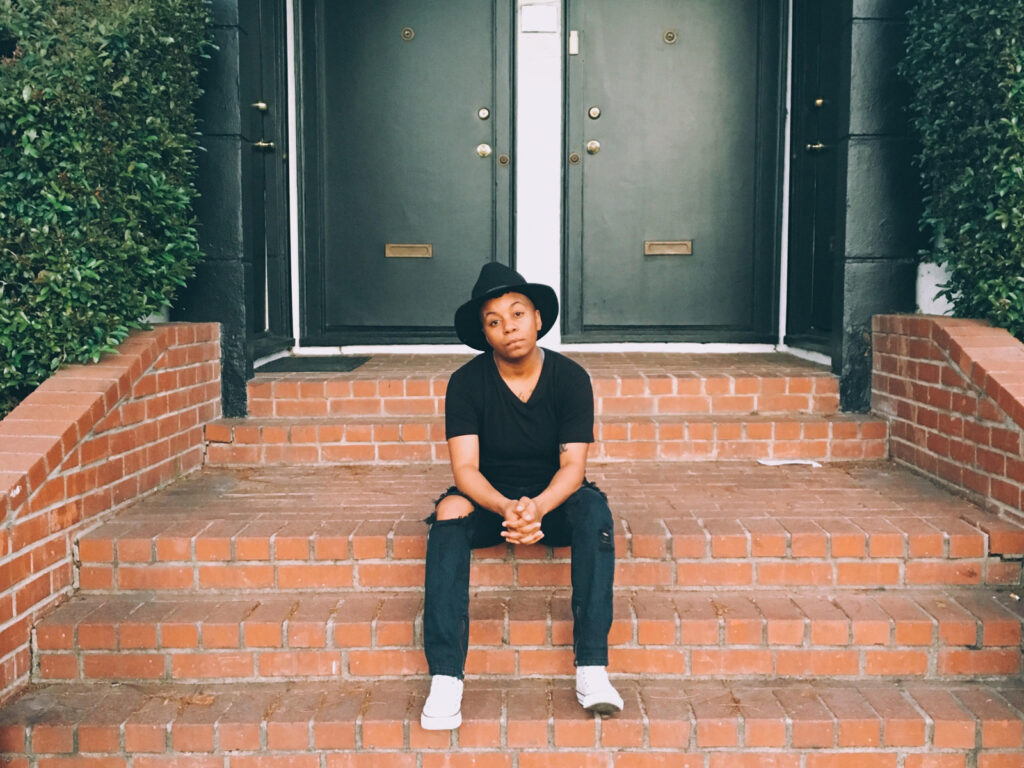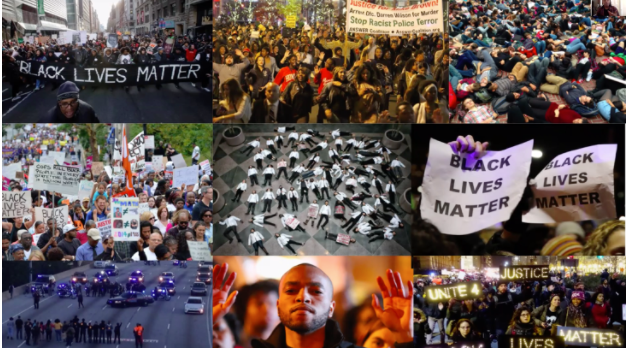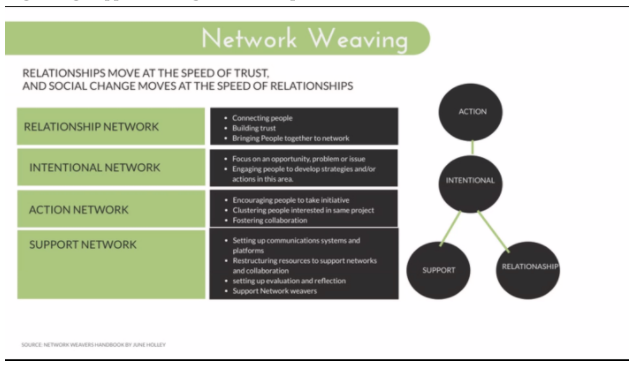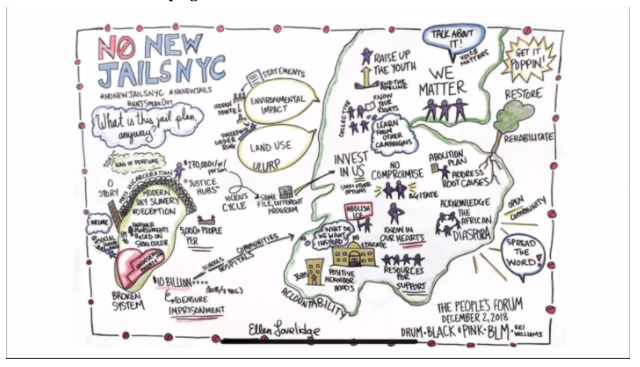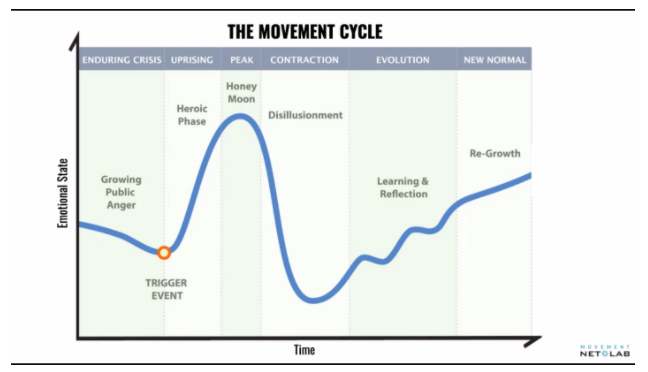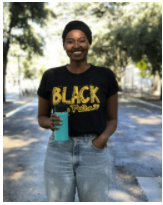In this month’s feature, Kei Williams shares their “activating moment,” touches on movement building tools and shares their admiration for structural networks that are not only principles-based but continue to grow and meet the needs of the community. Material for this blog was compiled and transcribed by Sadia Hassan from the Decentralized Networks and the Black Radical Tradition community of practice gathering in March, 2020.
Kei is a queer transmasculine identified designer, writer and public speaker. A founding member of Black Lives Matter Global Network, Kie’s work is to transform global culture towards the systemic analysis of structural racism. As Movement Net Lab’s StrategicNetwork Mobilizer, Kei creates powerful conceptual and practical tools that factor in the growth and effort of the most dynamic and emerging social movements of our time. Kei is also the Lead organizer for Safety Beyond Policing, Swipe it Forward, and Trans Liberation Tuesday.
Kei aims to use their platform to center communities who identify as queer, trans, gender non-conforming, and those living with mental illness. Before the lockdown, Kei was active in engaging communities in the Black Gotham Experience, an immersive visual project exploring the impact of the African Diaspora on New York City.
ACTIVATING MOMENT: HOT SUMMER OF 2014
Every organizer has an activating moment, a political event that pulls them out of the mundane rituals of everyday life into a political awakening. For Kei, it was the Ferguson Rebellion. A rebellion which spanned months and sparked protests in other cities. The rebellion, which resulted from the state sanctioned murder of Michael Brown, was the first time Kei saw America attacking its citizens in a hyper-militant way in response to young folks rebelling against police shootings.
LANGUAGE MATTERS: REBELLION VS RIOT
Ferguson is often called an uprising or a riot, reducing the well-organized and strategic collective actions of protestors to the haphazard and agent-less language of “violent unrest.” For Kei, the word rebellion honors the risk of organizers who choose to build community under surveillance as they continue to fight in the street against the state. Historically, the state has considered the rebellions of enslaved BIPOC people as disconnected from the systemic violence they endure in their everyday lives. One reason the Black Gotham Experience has been so important to Kei is precisely because it connects the struggles of enslaved folks who rebelled in 1712 and 1741 against the institution of slavery and Wall Street to the current collective struggle for Black liberation, what Marc Lamont Hill calls “a principled, righteous rebellion.”
COLLECTIVE ORGANIZING IS A BLACK RADICAL TRADITION
Ferguson benefitted so much from organizing that was already being done by local Black Lives Matter chapters operating loosely in various cities in response to police shootings in 2012/2013 (Trayvon Martin, Rekia Boyd, Shereese Francis). What Kei saw in the three to four years of organizing with the Black Lives Matter Global Network was that movements have to be guided by principles, strive to create cultural change, and bear a rallying cry (Black Lives Matter, 99% vs 1%) that appeals to communities under attack. As a young organizer, Kei has appreciated stepping into the radical traditions that were developed by Black Lives Matter and the lessons learned from the Occupy Movement, chiefly that it’s important to foreground what is being fought for as much as what is being fought against.
Questions to ask as you lean into organizing:
- What exists beyond the moment?
- What does it mean to be in solidarity with each other?
- What are we fighting for/towards that’s gonna be a transformative system?
THE FUTURE OF THE DECENTRALIZED NETWORK
BLM NYC Chapter helped create a lot of the structural webbing for the Global Network. People like Allen Frimpong, Arielle Newton, Monica Dennis had been working with June and other decentralized Network Organizers to determine what the structure of the Global Network was going to look like and what was power going to look like in all of these different places. We have a history of hierarchical structures in organizations but it takes radical imagination to have a decentralized network that is uniform but can grow to scale.
Questions to ask when building decentralized networks:
- What does a decentralized structure look like?
- What needs to be done differently?
- How can we grow it to scale?
- How will we know when to keep it localized?
- What is power going to look like?
- Where am I? Where am I going?
- Where do I/my skillsets fit in?
ORGANIZING HAPPENS THROUGH RELATIONSHIPS
You have to have trust and good relationships for any organizing effort to work.
In 2014, organizers learned that detainees in the Federal detention center (MDC) didn’t have heat and were being kept in their freezing cells in the middle of a polar vortex. Two close friends called Kie and asked them to come down. Kei felt compelled to show up as a movement organizer and friend because of the relationships they had built. Over fifty people joined the action and occupied the parking lot, staying for 3 weeks. People slept in tents with propane heaters. Medics signed up to wake folks up every thirty minutes.
What came out of that small occupation was a sense of solidarity and a network build-out of medics, emergency responders, family and friends who continued to organize for detainees at MDC. People were brought in based on how they fit, what skills they offered, who they were connected to and could support.
Some principles of Decentralized Networks that create cultural shifts and community action:
- Relationship & Culture of Trust
- Looks like: building a culture around trust and communication
- Self-Organizing:
- Looks like: a culture of empowerment, self-determined and innovative work flows
- Structure and support:
- Looks like: twitter hashtags, cultivating alternate/virtual convening spaces (slack, mighty networks, etc), liberating structures, learning pods
NO NEW JAILS NYC CAMPAIGN:
BLM NYC and a lot of other collectives came together and created a de-centralized, multiracial, intergenerational network. First order of business was to create a network mapping to map the people who were in the room and what they wanted to see.
One of the accomplishments of No New Jails NYC is the conversation about abolishing jails and releasing incarcerated people that have become amplified during the pandemic. The demand came from decades of organizing as black and brown people and is abolitionist in principle. The current campaign that brings them all together is the Free Them All for Public Health campaign. Culturally, there was already a framework and a cultural language that influenced the Free Them All for Public Health campaign which began with #CLOSErikers in response to Khalief Browder’s death and now in response to Covid19.
Free Them All is going global, to focus on incarcerated people worldwide. The first thing it did when the pandemic began was lead a soap drive with jail and prison abolition networks. They understood how covid19 was going to face huge risks because the state of the jails are inhumane. Decentralized organizing means trying to look at things as a hub of demands and circles of support. It’s important to get plugged into mutual aid but as network and movement builders we have to lean in and build other movements. We have to find the scaffolding where movements overlap and maximize impact.
KNOW YOURSELF, KNOW THE CYCLE
As “networked social movements” continue to transform the political landscape, Kei emphasizes that Movement Net Lab has grounded their language, curriculum, design sense, and style in how they approach decentralization. Here is a map they’ve provided that illustrates the flow of a movement cycle so we can better map our interventions alongside it’s ebbs and flows.
It’s important to know the constant flow of a movement cycle.
1. Urgency overlaps with a sense of history → Trigger moment: Eric Garner → Heroic Phase: we’re gonna win → Honey Moon: action, in the streets/protesting, sweet moment where anything feels possible→ Disillusionment: didn’t get the demand → Reflection: what we learned, who we worked with, shouldn’t work with → Regrowth: what now?
2. Movement cycles allows us to map and build off of legacies that have existed for a long time
3. Knowing the movement cycle helps clarify where our skills best fit and where interventions can be most effective
If you have any questions, concerns or corrections, or to pitch a blog post please email us at networkweaverblog.com.
About the author:
Sadia Hassan is a facilitator and network weaver who has enjoyed helping organizations use a human-centered design approach to think through inclusive, equitable, and participatory processes for capacity building.
She is especially adept at facilitating conversations around race, power, and sexual violence using storytelling practice as a means of community engagement and strategy building.
She is an MFA candidate in Poetry at the University of Mississippi and has a Bachelor’s degree in African/African-American Studies from Dartmouth College.
Related Posts
November 4, 2024
Receiving Love and Care: A Liberatory Practice
June 21, 2024

